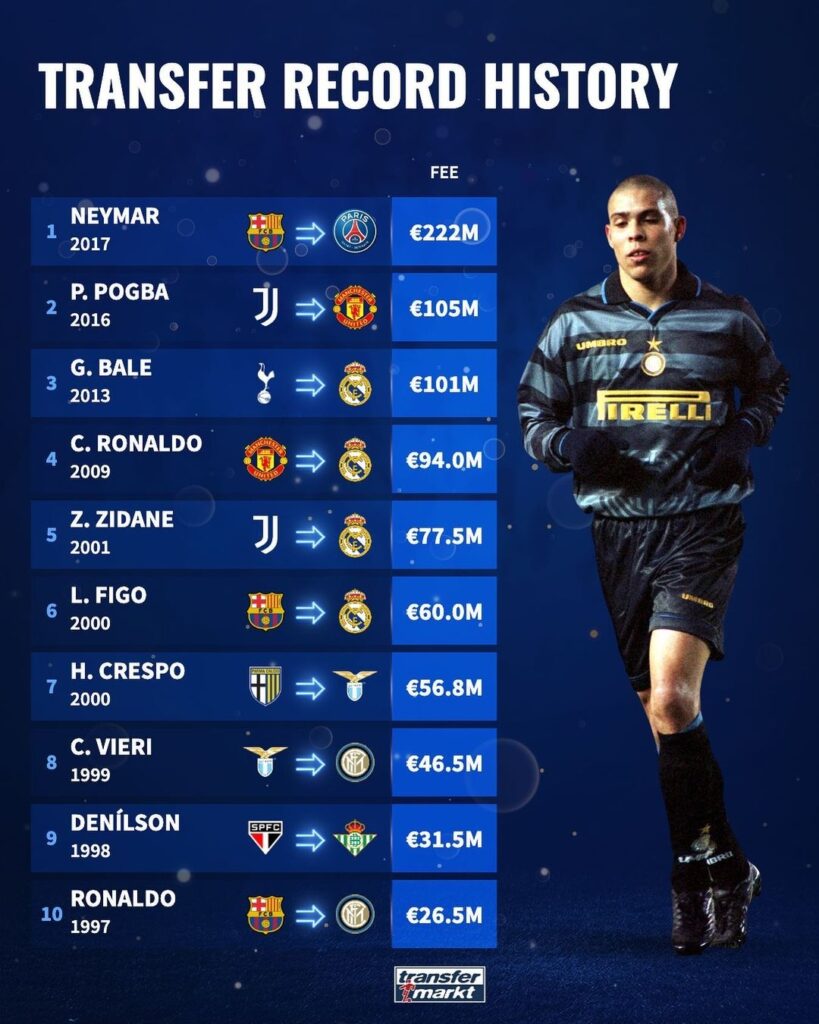Football fans often see headlines about mega-deals—like a forward signing for €100 million—and assume that’s the total price. But anyone who’s looked under the hood knows there’s a lot more to it. From long contracts designed to spread costs over many seasons, to bonuses triggered by performance, to hefty signing fees on “free” transfers, the real cost can skyrocket far beyond the initial figure. In this edition, we’ll explore these hidden dimensions and real-life examples to understand what clubs truly pay when they sign a player.
Transfer Fees and Amortisation
A transfer fee is what the buying club pays the selling club for the player’s registration. However, under accounting rules, clubs often split the cost over the life of the player’s contract, a process called amortization.
- Chelsea’s Long Contracts
Recently, Chelsea has been giving new signings contracts of 7 or even 8 years. This approach lowers the annual amortized cost. For instance, if they pay €70 million for a player on a 7-year deal, that’s €10 million per year for accounting purposes. This helps the club meet Financial Fair Play (FFP) requirements.
- Chelsea’s Long Contracts
But the flip side is if the player doesn’t perform or no longer fits the manager’s system, the club remains committed to that 7- or 8-year contract and the annual amortisation expense.
Wages and the Risk of Long Contracts
Base Salary
Beyond the transfer fee, the club negotiates a weekly or annual wage with the player. Over a 5- or 6-year deal, these wages often exceed the original transfer cost, especially for stars earning €200,000–€400,000 per week.
When Long Contracts Go Wrong
A lengthy contract can be a double-edged sword. While it allows the club to spread out the transfer fee, it also locks them into paying high wages if the player’s form dips.
Layvin Kurzawa’s Extension at PSG
In 2015, Layvin Kurzawa joined Paris Saint-Germain. Five years later, in 2020, the club decided to extend his contract for four more years, much to everyone’s surprise—including Kurzawa himself. As he revealed:
“I didn’t understand the extension either. I was at home and at the time there was an aborted transfer with Juventus. The jet was ready for Turin and my former agent called to tell me that Paris wanted to extend my contract by four years. I’m also wondering what happened. You offer me that, of course I’m not going to say no. Who says no to a contract where you get a raise and so on?”
This kind of scenario—where a player gets a long-term contract but later struggles to meet expectations—has happened multiple times in recent years at top clubs.
When Transfer Fees Are Not Fully Guaranteed
The headline figure we see in the media often includes both fixed fees and potential bonuses. These bonus payments, or “add-ons,” hinge on certain achievements.
- Vitor Roque at Barcelona
One recent example is Vitor Roque, who joined Barça in 2024. Media outlets often quote a €60 million fee, but in reality, the fixed portion is €30 million, with another €30 million in bonuses. As Barcelona Sporting Director Deco explained:“Vitor Roque cost 30 million euros, not 60 million euros, because no bonus was reached. He hasn’t won any titles with us or reached a certain percentage of games, so it’s only 30 million euros.”
- Vitor Roque at Barcelona
By structuring deals this way, clubs limit upfront spending. They only pay more if the player meets performance or appearance milestones, or if the club itself achieves certain objectives (like winning a league title or going far in a European competition).
Agents’ Fees and Commissions
Agents play a crucial role in orchestrating transfers. Their commissions can easily range from 5% to 10% of the transfer fee and might also include a cut of the player’s wages. In some well-documented moves, agents have taken home tens of millions of euros for a single high-profile transfer.
While clubs often try to negotiate lower commissions, competition for star players means agents frequently hold substantial leverage—especially if multiple top clubs are vying for the same signature.
Signing-On Bonuses and “Free” Transfers
A “free” transfer happens when a player’s contract ends, and they move without a conventional transfer fee. However, it’s rarely free from the club’s perspective because:
- Signing-On Bonus: The club usually pays the player a sizable lump sum.
- Agent and Representative Fees: Agents might demand high commissions since there’s no transfer fee to negotiate.
- Mbappé’s Move to Real Madrid
Reports have circulated about Kylian Mbappé’s free transfer to Madrid, mentioning a €120 million signing bonus. That eye-popping figure underscores how “free” transfers can be incredibly costly, once bonuses and fees are factored in.
- Mbappé’s Move to Real Madrid
Summing Up the Real Costs
Performance-Based Add-Ons
Clubs often build additional clauses into contracts. These could reward players for winning the Ballon d’Or, a league title, or a certain number of goals in a season. Each triggered clause raises the total cost.
Taxes and Insurance
Every league has its own tax rules. In some cases, clubs offer “net” salaries, meaning they pay the taxes themselves—a hidden expense that can significantly inflate wage bills. There’s also insurance, which grows more expensive the higher the transfer fee and salary.
Financial Fair Play (FFP)
All of the above factors—transfer fees, wages, bonuses—must fit within FFP regulations. Clubs that overspend risk fines or even bans from European competitions. This forces clubs to carefully balance their books, sometimes leading to quick sales of valuable players if finances become tight.
A Historical Perspective: The Rise of Transfer Fees
Up until 1997, the highest transfer fee in football was the Brazilian Ronaldo’s move from FC Barcelona to Inter Milan for around €27 million, a figure that stunned many at the time. Before and around then, paying €8 million for a player was seen as extravagant. Yet in today’s market, a fee of that size typically goes toward a veteran nearing the end of their career or a relatively unknown prospect. Several factors explain this dramatic inflation. The Bosman ruling in 1995 gave players more freedom at the end of their contracts, which significantly raised wages and fees. Meanwhile, TV and sponsorship revenues ballooned, pouring billions into the sport and enabling clubs to spend huge sums on star acquisitions. Finally, an influx of global investors created fierce competition for the best talent, pushing many transfers beyond €100 million, with Neymar’s €222 million move to PSG in 2017 still standing as an extreme example of how far the market has come.
In Summary
When you see a “€50 million” or “€100 million” headline fee, remember it’s just one piece of the puzzle. Some clubs, like Chelsea, hand out seven-year contracts to spread the fee over many seasons. Others, like PSG with Layvin Kurzawa, end up stuck paying wages for years, even when a player’s role diminishes. Bonuses and add-ons can double a transfer’s overall price, as seen with Vitor Roque’s deal at Barcelona. Even “free” transfers can come with huge signing-on fees, like Mbappé’s rumored €120 million bonus from Real Madrid.
For fans wanting a deeper understanding of football’s finances, these examples show how the real cost of a player can balloon well beyond the initial fee—and why clubs must plan carefully to avoid long-term liabilities that hamper both their sporting and financial success.

https://www.uefa.com/insideuefa/protecting-the-game/club-licensing
Club Financial Statements (various)
(Official reports from top clubs often detail wage bills, amortization, and total expenses)

